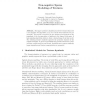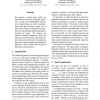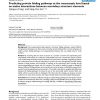498 search results - page 29 / 100 » Learning structured prediction models: a large margin approa... |
BMCBI
2008
13 years 8 months ago
2008
Background: We consider the discovery of recombinant segments jointly with their origins within multilocus DNA sequences from bacteria representing heterogeneous populations of fa...
BIBM
2010
IEEE
13 years 5 months ago
2010
IEEE
The emergence of data rich domains has led to an exponential growth in the size and number of data repositories, offering exciting opportunities to learn from the data using machin...
SCALESPACE
2007
Springer
14 years 2 months ago
2007
Springer
This paper presents a statistical model for textures that uses a non-negative decomposition on a set of local atoms learned from an exemplar. This model is described by the varianc...
ACL
2009
13 years 6 months ago
2009
We present a global joint model for lemmatization and part-of-speech prediction. Using only morphological lexicons and unlabeled data, we learn a partiallysupervised part-of-speec...
BMCBI
2008
13 years 8 months ago
2008
Background: Since experimental determination of protein folding pathways remains difficult, computational techniques are often used to simulate protein folding. Most current techn...



